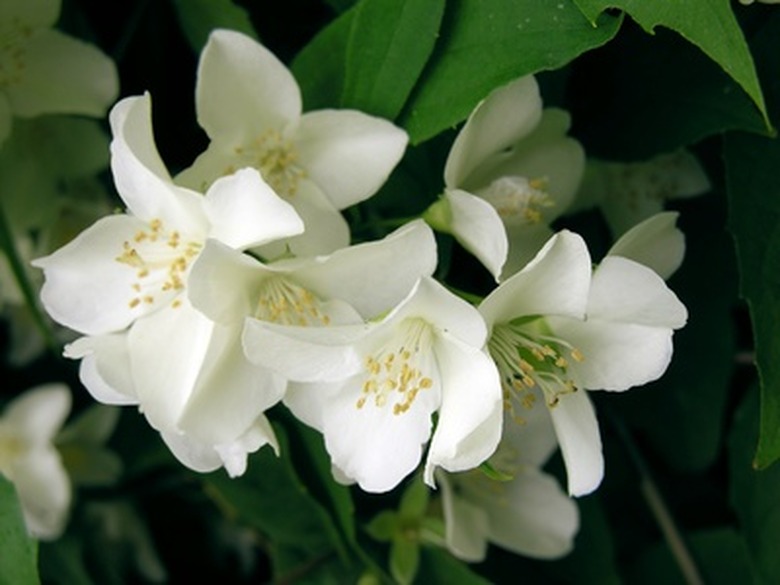The History Of The Jasmine Flower
The word jasmine is derived from the Arabic word "yasmin," which means fragrant flower. Jasmine often has white or yellow star-shaped flowers that grow on vines or as shrubbery. The genus jasmine, botanically named jasminum, is part of Oleaceae, or olive, family. Other spellings for jasmine through the ages have included jessamine, gessamine, jasmin, jessamy and jeshamy, according to Harvard University's Arnold Arboretum.
Early History
Of the 200 species of jasmine, the first plant known by the name was Arabian jasmine, known by the scientific term Jasminum sambac. This may be the best starting point to trace the history of jasmine flowers. Without a doubt, this tropical and subtropical flower is native to Asia. Many botanists believe Persia, now Iran, is where jasmine originated. It crossed the Red Sea into Egypt as early as 1000 B.C., then found its way to Turkey and Greece.
- The word jasmine is derived from the Arabic word "yasmin," which means fragrant flower.
- Of the 200 species of jasmine, the first plant known by the name was Arabian jasmine, known by the scientific term Jasminum sambac.
Geographical Movement
The emperors of China's Sung Dynasty (960 to 1279 A.D.) found the fragrance of jasmine immensely enjoyable. In the 1400s, the kings of Afghanistan, Nepal and Persia ordered jasmine planted around their residences. It is believed the Moors introduced jasmine to Spain during the 1600s. Other western European countries like Italy and France quickly embraced jasmine flowers. The only continents without native species of jasmine are Antarctica and North America, according to the New World Encyclopedia.
Jasmine in the Philippines
It is believed that Jasminum sambac, Arabian jasmine, was brought to the Philippines from central Asia in the 1700s. Its white, star-shaped flowers captured the attention of the nation's people. They admired the novel flower that opens at night and has a bud that is more fragrant than the actual flower. It's little wonder that jasmine has been the national symbol of the Philippines since 1934. Jasmine was chosen to represent purity, simplicity, humility and strength.
- The emperors of China's Sung Dynasty (960 to 1279 A.D.) found the fragrance of jasmine immensely enjoyable.
- In the 1400s, the kings of Afghanistan, Nepal and Persia ordered jasmine planted around their residences.
Fragrance
The varieties of jasmine are used for different purposes. Jasminum officinale is best known for its fragrance. Jasminum grandiflorum, commonly called Spanish or Catalonia jasmine, has been cultivated in France for use in perfume for centuries, and continues to be part of the perfume industry that's vital to the French people.
Jasminum sambac is used to make jasmine tea. As early as the 13th century, the Chinese were scenting their green tea with jasmine. Chinese herbalists continue to use jasmine to treat headaches, insomnia and bone pain.
Symbolism and Religion
To the Chinese, jasmine represents feminine kindness, grace and delicacy, as well as a means of attracting wealth and romance. In Thailand, jasmine symbolizes motherhood, while in India, Jasminum molle, commonly called Indian Jui, is used in Hindu religious ceremonies.
- The varieties of jasmine are used for different purposes.
- Jasminum grandiflorum, commonly called Spanish or Catalonia jasmine, has been cultivated in France for use in perfume for centuries, and continues to be part of the perfume industry that's vital to the French people.
Modern Uses
In Hawaii, Jasminum sambac, with its clustered white flowers, is called "pikake" and fashioned into leis. In aromatherapy, jasmine is used for its relaxing qualities in pure flower form, as an essential oil, or in scented candles and incense. Culinary aficionados use jasmine as a garnish and in delectable pastries.
